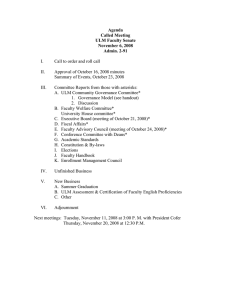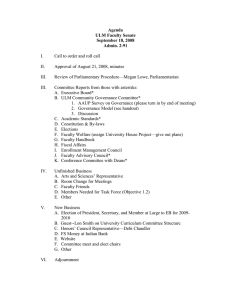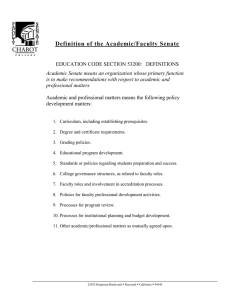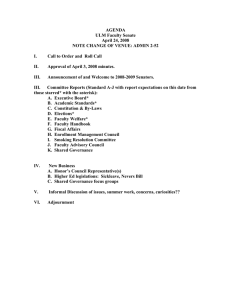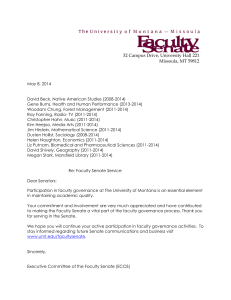Explanation of Representation Proposed University Senate Structure
advertisement
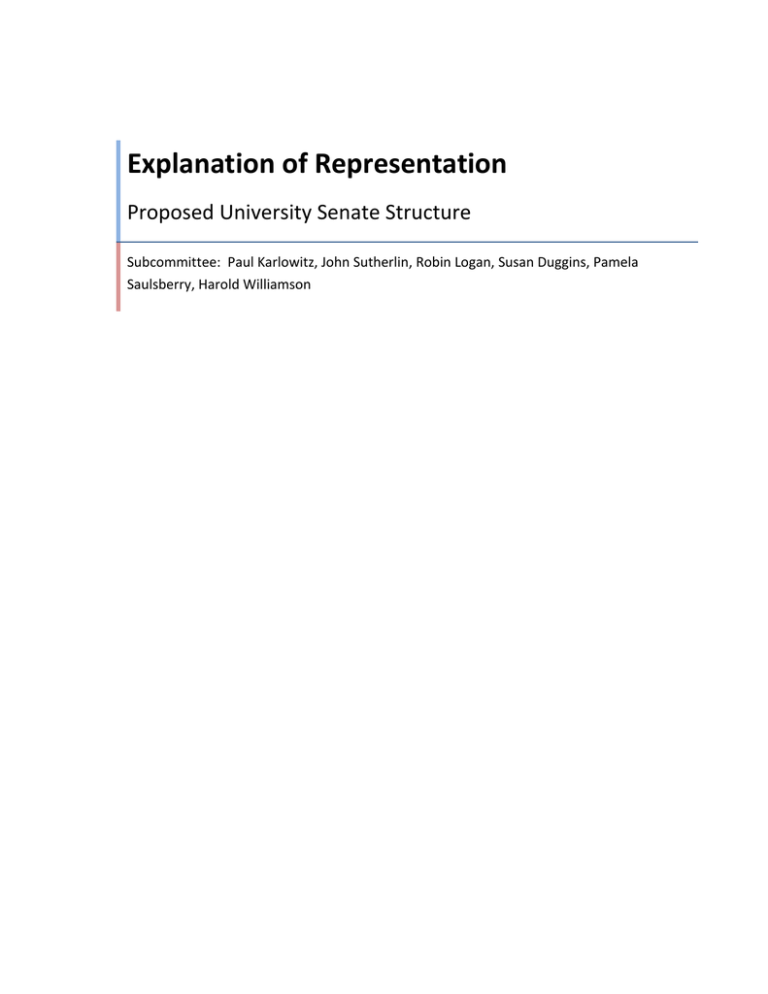
Explanation of Representation Proposed University Senate Structure Subcommittee: Paul Karlowitz, John Sutherlin, Robin Logan, Susan Duggins, Pamela Saulsberry, Harold Williamson Discussion of Shared Governance Models Shortly after the formation of the shared governance committee, there began a series of discussions about what the appropriate model or structure would be for facilitating shared governance. While everyone confirmed the value and importance of the existing Faculty Senate as one of the mechanisms for shared governance, the committee remained undecided about how to best incorporate others that were part of ULM (i.e., staff, students, alumni). Once staff representation was discussed, many felt that attempting to expand shared governance through the Faculty Senate only structure would not work. The options for the shared governance committee are many. The deliberations have included a variety of models and approaches. All of these, however, essentially revert back to the same questions: • Who participates in shared governance? • What structure best represents ULM? • What system encourages more cooperation and less conflict? In addressing these fundamental concerns, the shared governance committee has proposed a broad framework based on Louisiana Tech's University Senate (http://www.latech.edu/universitysenate/). Representation for faculty and staff (as well as students and alumni) has been a major source of discussion, disagreement and finally some resolution. Still, what is offered below is a place to begin, not end. There are many models for shared governance. Other options within the UL System would include: http://www.mcneese.edu/depts/facsenate/ http://www2.selu.edu/Academics/Depts/FacSen/ http://www.louisiana.edu/Faculty/Senate/ Other prominent examples: http://www.tulane.edu/~usenate/ http://www.columbia.edu/cu/senate/ http://www2.gsu.edu/~wwwsen/ http://senate.osu.edu/ http://www.suny.edu/facultySenate/ 1 Explanation of Representation The Shared Governance Models Subcommittee was charged with the task of researching and recommending a shared governance model to be submitted to ULM focus groups. The following proposal is based upon ULM 2007 – 2008 Organizational Chart and ULM Fall 2007 Human Resources data as of the standard reporting census date of November 1st, as collected for state and federal reporting. Each of the following factors were considered by the subcommittee when constructing the proposed allotment: • It is essential to keep the total number of seats within a manageable number of 40 or less. This reflects the size of other representation models across the country. • • It should represent faculty, staff, students, and alumni. The structure should follow the organizational chart, following the Vice‐Presidential divisions. In Academic Affairs, non‐academic departments are to be considered independently of academic departments. o It is suggested that certain non‐academic offices to be designated a seat due, in part, to the continual need for information and feedback from these areas (i.e., University Police, Human Resources, Enrollment Management, University Library, and others). o Other non‐specified non‐academic departments will be represented through the remaining seat for the specified area. o For academic areas, it is suggested, according to student enrollment and full‐ time faculty, that Arts and Sciences hold 6 seats with the other colleges holding 3 seats each. Note: The Graduate Studies and Research should be included in the Academic areas. o One of the Deans should hold a seat on the University Senate. It is intended that the Deans should rotate on a yearly basis. • It is recommended that Department Heads, both academic and non‐academic, be eligible to serve. • The officers for the University Senate will be elected from within the 38 members. Note: The nomination, election, and term details for the University Senate still needs to be determined. [President, President‐elect, Past‐President, Secretary] The following amendments to the proposal were added by the Shared Governance Committee: • • An Alumni representative be added, and reflected in the External Affairs seats. For the first year only, the Past‐President will be the outgoing Faculty Senate President. After that time, the outgoing University Senate President will hold this position. 2 The committee felt that these topics needed to be addressed as further discussion takes place about the structure and responsibility of the chosen governance model. • Updates from university departments presented to the governing body in a scheduled manner, i.e., Student Affairs would address policy changes biannually, if appropriate. • • • • Nomination procedure Term limits / rotations Committee structure LA Tech model appears to be the example of choice 3 The following proposal is based upon ULM 2007 – 2008 Organizational Chart and ULM Fall 2007 Human Resources data as of the standard reporting census date of November 1st, as collected for state and federal reporting. Table 1 – Academic Representation Academic Academic Affairs Division Type Area # Departments # Faculty # Full Time Faculty # Department Heads° % Fall 06 Students % Fall 07 Students Total Seats Arts and Sciences 17 180 161 15 30.6 31.9 6 Business Admin. 8 43 39 9 16.3 16.9 3 Ed. & Human Dev. 5 57 39 5 13.2 12.6 3 Health Sciences 8 70 48 7 18.3 17.8 3 5 48 45 8 11.2 10.2 3 10 9.9 1 44 19 ♦ Pharmacy Graduate Studies & Research* Subtotal ‐ Academic 43 398 332 °The number shown as Department Heads employees are in additional to the “faculty” counts. This does not include the Deans, Associate Deans, and Assistant Deans; for Arts and Sciences, this does not include the Division of Theatre and Dance. Please note: In some areas, more than one person may hold a “director” or “department head” title. ♦ College of Pharmacy: PharmD professional enrollment is counted as part of the Pharmacy percentage. Their Masters and Doctoral enrollment is counted as part of the Graduate Studies and Research count. Please see Table 3.b for more information. *Graduate Studies and Research: This is intended to be counted as an academic entity – representing GS&R, as well as the graduate programs (PharmD Professional included with Pharmacy). 4 Table 2.a – Non‐Academic Representation Division Type Area Non‐Academic # Departments Total Employees Total FT Employees # FT Unclassified Employees Total Seats 16 139 135 98 4 Enrollment Management University Library Academic Affairs Dean (rotating yearly) All other Administrative Offices under Academic Affairs, including: Assessment and Evaluation, Continuing Education, Copy Center, TLRC, University Planning and Analysis, Soil and Plant Analysis Lab, Public Radio, Tumor Registry, and LA SBDC Non‐Faculty Academic§ 44 163 156 103 1 Arts and Sciences 17 48 44 33 Business Admin. 8 14 13 7 Ed. & Human Dev. 5 17 17 8 Health Studies 8 19 18 9 Pharmacy 5 60 59 45 Graduate Studies and Research 1 5 5 1 §The Non‐Faculty Academic breakdown represents the non‐instructional faculty working in the Academic Departments. These are not included in the Academic counts in Table 1, and not included in the employee totals for the Non‐Academic Offices in Academic Affairs shown in Table 2. Please note: The Deans, who are included in the employee count for this section, are allotted a seat under the Academic Affairs Administrative section. Department Heads are reflected in the Academic counts in the Table 1. 5 Table 2.b – Non‐Academic Representation (continued) Division Type Area # Departments Total Employees Total FT Employees # FT Unclassified Employees Total Seats 10 290 284 57 4 Non‐Academic Facilities and Physical Plant combined Business Affairs Human Resources Computing Center All remaining areas in Business Affairs, including: Auxiliary Enterprises, Controller’s Office, Budget and Investments, Graphic Services, Purchasing. This will also include the Office of Internal Audit. External Affairs Non‐Academic 5 + Alumni Foundation 26 26 19 2 73 69 28 3 Alumni Association President All other areas in External Affairs Non‐Academic 11 University Police Student Affairs Athletics Non‐Academic Counseling Center All other areas in Student Affairs, including: Aquatic Services, Assistant Dean of Students, Career Services, Project Talent Search, Recreational Services, Student Health Services, Student Life and Leadership, Student Services and Judicial Affairs Sub‐Total Non‐Academic 16 50 48 45 2 53 572 560 245 16 2 Total Students: 8,541 Students Total Full Time Students: 6,593 Student Government Association Campus Activities Board Provost – ex‐officio – (non‐voting) 1 Total University Senate Representation 38 6 The following proposal is based ULM Fall 2007 14th Class Day Enrollment, as collected for state and federal reporting. Table 3.a – Student Enrollment by Status and Level Fall 2006 Fall 2007 # % # % Undergraduate 5,911 69.0 5,865 68.4 Graduate 349 4.1 335 3.9 Professional 419 4.9 393 4.6 Subtotal 6,679 77.9 6,593 76.9 Undergraduate 1,372 16.0 1,432 16.7 Graduate 508 5.9 513 6.0 Professional 12 0.1 3 0.0 Subtotal 1,892 22.1 1,948 22.7 Full Time Part Time Total 8,571 8,541 Table 3.b – Student Enrollment by Level and College Fall 2006 Fall 2007 # % # % Arts and Sciences 2,624 30.6 2,730 31.9 Business 1,401 16.3 1,447 16.9 Education 1,132 13.2 1,083 12.6 Health Sciences 1,571 18.3 1,529 17.8 Pharmacy 535 6.2 480 5.6 Non‐Degree 20 0.2 28 0.3 7,283 85.0 7,297 85.1 Arts and Sciences 159 1.9 126 1.5 Business 71 0.8 63 0.7 Education 420 4.9 436 5.1 Health Sciences 39 0.5 39 0.5 Pharmacy 116 1.4 144 1.7 Non‐Degree 52 0.6 40 0.5 857 10.0 848 9.9 431 5.0 396 4.6 431 5.0 396 4.6 Undergraduate Undergraduate Subtotal Graduate Graduate Subtotal Professional Pharmacy Professional Subtotal Total 8,571 8,541 7 2007 – 2008 ULM Organizational Chart 8
